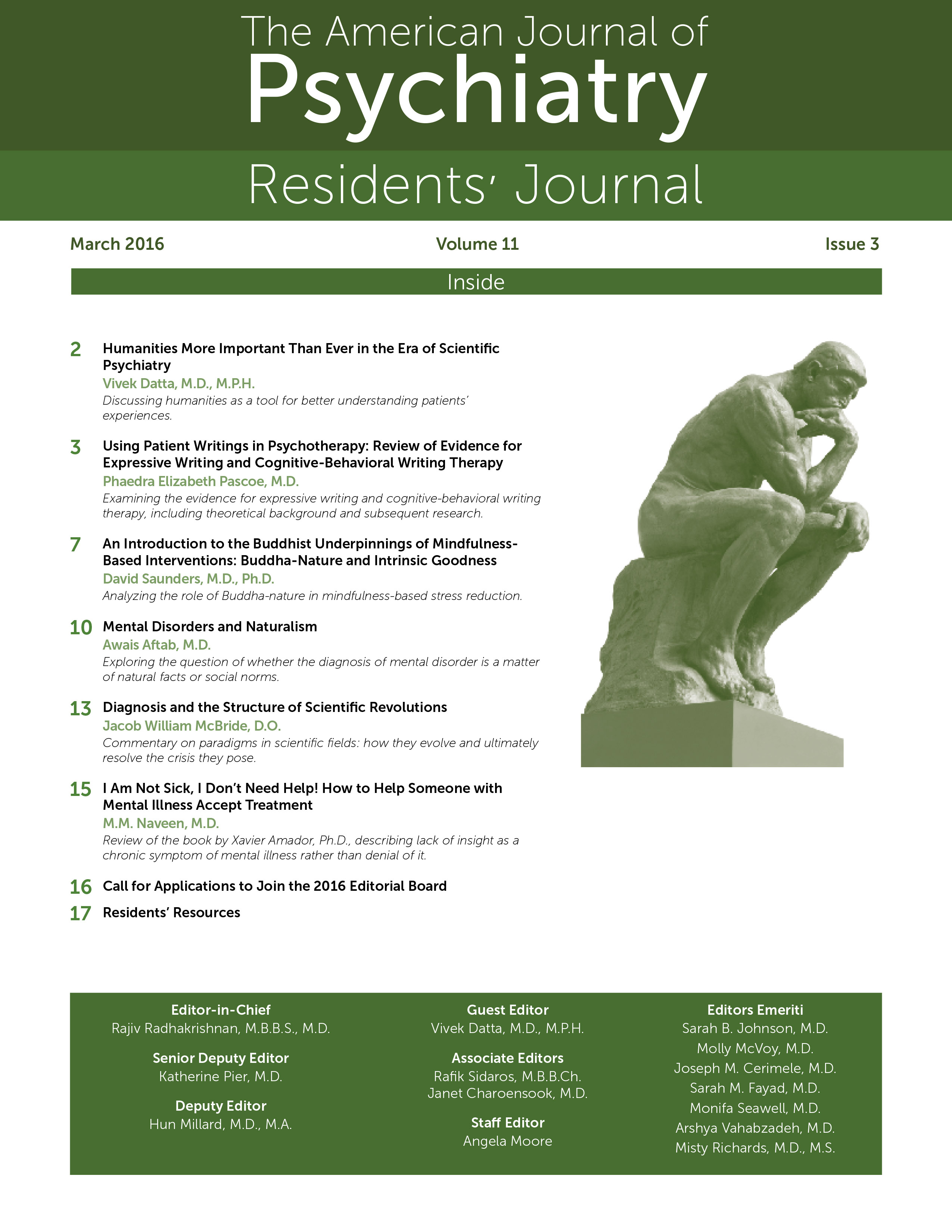Using Patient Writings in Psychotherapy: Review of Evidence for Expressive Writing and Cognitive-Behavioral Writing Therapy
Expressive Writing
Theoretical Background and Initial Study
Subsequent Research and Meta-Analyses
| Study | Psychiatric Diagnosis of Individuals Included in the Study | Location From Where Participants Were Recruited | Number of Participants/Percentage Completion | Duration and Timing of Expressive Writing | Timing of Assessments | Primary Outcome Measures | Summary of Results |
|---|---|---|---|---|---|---|---|
| Baikie et al. 2012 (17) | Mood disorders (85% of participants had depression, 21% had depression and anxiety) | Advertisement on website about depression | 688/40% | Four 20-minute sessions over 2 weeks | After completion of expressive writing and after 1 month and 4 months | Center for Epidemiologic Studies Depression Scale, Depression Anxiety Stress Scale, Pennebaker Inventory of Limbic Languidness, overall health questions, Temperament and Personality Questionnaire (TPQ), and COPE Inventory (COPE). | Individuals receiving active interventions (expressive writing and writing about positive events) demonstrated significant improvement in the stress subscale of the Depression Anxiety Stress Scale compared to controls |
| Krpan et al. 2013 (18) | Major depressive disorder | Local advertisements | 44/90% | Three 20-minute sessions over 3 days | After completion of expressive writing and after 1 month | Beck Depression Inventory and Patient Health Questionnaire 9 (PHQ-9) | Individuals using expressive writing showed significant decreases in depression compared to controls |
| Sloan and Marx 2004 (11) | PTSD | Introductory psychology college course | 51/96% | Three 20-minute sessions over 3 days | After completion of expressive writing and after 1 month | Posttraumatic Stress Diagnostic Scale, Beck Depression Inventory, Pennebaker Inventory of Limbic Languidness, cortisol level | Significant decreases in PTSD symptoms, depression and physical symptoms |
| Smyth et al. 2008 (19) | PTSD | Trauma care agencies | 25/96% | Three 20-minute sessions over 1 day | After completion of expressive writing and after 3 months | PTSD Symptom Scale Interview (PSS-I), Profile of Mood States (POMS), Post-Traumatic Growth Inventory (PTGI), cortisol level | No significant difference in PTSD symptoms between groups, individuals using expressive writing showed significantly larger reduction in tension and anger in comparison with controls |
| Meshberg-Cohen et al. 2014 (20) | Substance use disorders (more than 50% had comorbid PTSD) | Residential treatment facility | 129/95% | Four 20-minute sessions over 4 days | After completion of expressive writing and after 2 weeks and 1 month | Posttraumatic Stress Diagnostic Scale, Center for Epidemiologic Studies Depression Scale, Pennebaker Inventory of Limbic Languidness, Brief Symptom Inventory (BSI), Positive and Negative Affect Scale (PANAS) | Significant difference between groups at 2 but not 4 weeks |
Cognitive-Behavioral Writing Therapy
Interapy
Subsequent Research
Conclusions
Key Points/Clinical Pearls
References
Information & Authors
Information
Published In
History
Authors
Metrics & Citations
Metrics
Citations
Export Citations
If you have the appropriate software installed, you can download article citation data to the citation manager of your choice. Simply select your manager software from the list below and click Download.
For more information or tips please see 'Downloading to a citation manager' in the Help menu.
View Options
View options
PDF/EPUB
View PDF/EPUBGet Access
Login options
Already a subscriber? Access your subscription through your login credentials or your institution for full access to this article.
Personal login Institutional Login Open Athens loginNot a subscriber?
PsychiatryOnline subscription options offer access to the DSM-5-TR® library, books, journals, CME, and patient resources. This all-in-one virtual library provides psychiatrists and mental health professionals with key resources for diagnosis, treatment, research, and professional development.
Need more help? PsychiatryOnline Customer Service may be reached by emailing [email protected] or by calling 800-368-5777 (in the U.S.) or 703-907-7322 (outside the U.S.).
